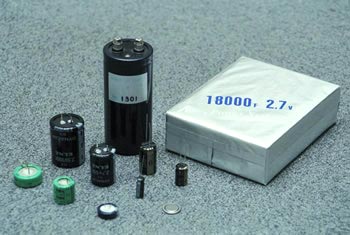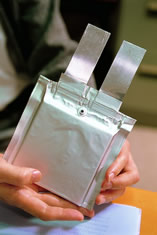| Web Japan > NIPPONIA No.28 > Special Feature* |
|
|
|
NIPPONIA No.28 March 15, 2004
|
|
Special Feature*

A see-through view of Honda's FCX fuel cell vehicle. The fuel cell is installed under the seats. The Ultra Capacitor, a power-storing device, is located behind the rear seats.
http://www.hondacorporate.com/fcx/ But still, they had only about one-twentieth the energy density of lead batteries. Okamura therefore oriented his research in two directions: (1) he sacrificed internal resistance and other capacitor factors, in order to raise energy density more; and (2) he set out to raise the peripheral electric circuit performance, in order to compensate for the factors he was sacrificing.
"I knew that if I boosted capacitor performance (energy density) five times, and raised the peripheral circuit performance four times, overall performance would be 20 times higher, since 5 × 4 = 20."
"I was going in the opposite direction from that being taken by major research projects at the time. Researchers still believed that lowering internal resistance was more important than raising energy density. Anyway, I tried out different simulations and found that my theory was right."
ECaSS can store the same amount of electric energy as a lead-acid battery, and is superior because the system life is longer and the charge time is shorter (since the energy is stored directly as electric energy, rather than being converted first).
After this breakthrough, Okamura's technology has been used since the late 1990s for a maintenance-free, non-interruptible power supply system made by an electric device manufacturer, and for the engines of electric hybrid trucks and buses that emit fewer particulates. Honda recently began using ECaSS in its no-emission fuel cell vehicles.
Okamura keeps pushing his technological revolution forward. His technical guidance helped JEOL Ltd. design the high energy density Nanogate Capacitor, released in October 2003. The Nanogate Capacitor stores two to three times more electric energy than lead-acid batteries of the same weight, a little more than nickel metal hydrite batteries (which are commonly used for small-size, low-output requirements), and almost as much as lithium ion batteries, which have the highest energy density of all batteries.
With further refinements, Energy Capacitor Systems will help electric cars take over from gasoline-powered models, and also serve as an electric energy storage system for the home. When that time comes, we will be able to efficiently store surplus electricity from solar panels, wind turbines, fuel cells and other non-polluting generators. One day, we may not need large generating stations and long, power-losing transmission lines. Capacitors have a hidden potential that will open up the future to many energy opportunities.
|
|||||||
|
||||||||
|
||||||||
|

